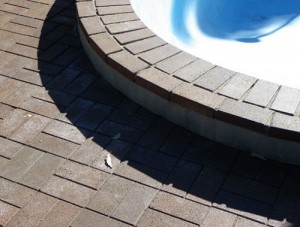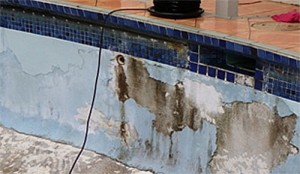1 Introduction:
When you come to look at and assess a concrete pool for re coating there are some aspects that you need to take note of apart from the internal surfaces. By doing so you will begin to understand the pools situation relative to other issues that may impact on your coating and its long term success. If you ignore these factors, then you run the risk of missing important clues, which may save you and the client much angst.
2 Concrete Shell:
When a pool is designed it will be with a compressive strength suitable for its intended use and with sufficient re enforcing steel correctly imbedded. As an example the engineer may specify 30 Mpa strength and at least 50 mm concrete cover for the steel work. The actual onsite results may not be such. Poor shotcrete application techniques, insufficient compaction, and movement of the steel reinforcing chairs, all lead to porous areas of concrete, insufficient cover and many other factors. These over time may show up with leaks, failure of the finishes and rusted steel work, staining the surfaces.
3 Look out for:
When assessing the pool in question check the following in addition to the normal items:
- Is the pool on a hill-side, or is there a nearby bank or hillside, that allows water run off or flow towards, under or around the pool and its immediate surroundings?
- Is the pool near the sea, marina, or river or at the bottom of a valley?
- Does roof or rain run off flow away from the pool area? If not be aware.
- Are the pavers or coping tiles, buckled, with gaps between them or lose?
- Is the pathway or coping tiles, pavers that surround the pool showing any signs of white efflorescence? (Also look at the tile line above the water for the same white efflorescence)
- Are the coping tiles or pavers dark in colour?
- If pool already painted, then are there any blisters on the existing paint (above or below the water line).
If you see any of the above factors then it’s highly indicative of water being in, around or under the pool and this may impact on the success of the coating, now or many years later on.
- Efflorescence is a very good indicator of water being in the concrete (or in the ground surrounding the pool) and as the water moves in and out of the substrate, (pool structure) leaving behind the white powder (efflorescence) as the liquid evaporates.
- Dark colour pavers or coping tiles on the tops of pool walls can heat up on summer days. Due the thermal differential with the bottom of the wall (being buried and much cooler) creates a wicking effect with ground moisture. The moisture rises up the walls and leaves near the top, often leaving telltale white efflorescence too.
- Any blisters in the existing pool coating, will indicate moisture passing through the concrete shell into the pool (hydrostatic pressure). Note: A well-worn, thin pool coating may not show any effects as the water and vapour can pass readily through it. A worn coating is one key reason to recoat a pool.
[ezcol_1half]


[/ezcol_1half] [ezcol_1half_end]


[/ezcol_1half_end]
4 Solutions:
The best coating to use in a concrete pool, is one that is both water and vapour proof, as it’s going to keep the pool (salty) water away from the reinforcing steel and save the pool owner issues to do with concrete cancer.
Our products fit this requirement well.
However, if there are issues with moisture within or under the concrete surface, there is a chance that in time it will cause the coating to blister. This can be hard to forecast, unless you see signs, as indicated on page one.
If you have seen these signs or have concerns, then you should:
- Advise the pool owner (in writing) of what you see and that there may be issues later on. As it’s not something you can be absolute about, its best to err on the side of caution.
- Consider the use of a water proofing coating first, namely Ardex WPM 300 (Ardex 02 9851 9199) This may be a good insurance policy. It can then be over coated once cured with our paints in the normal manner.
As an alternative, you may want to suggest the use of a porous finishing system, such as a trowel on finish, which generally lets water in and out of the pool surfaces. However, these being “open”, collect stains, dirt, algae and also let calcium nodules form.
5 Summary:
Water is insidious and can make one’s life difficult. More so if these aspects above are not noted and then considered. Most times there are no issues and the project goes well, as does the performance of the coating. However, every now and then, situations arise, which are quite easy to detect beforehand. When so noted and the issues discussed with the pool owner a resolution can be forthcoming or at least the situation monitored so that if matters arise later on, there are no surprises to argue over.
Contact us for more details.
